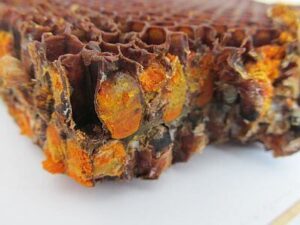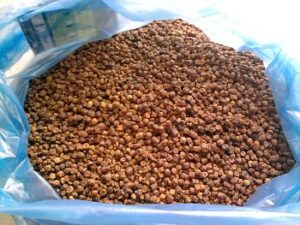A product made in the hive. Honey bees bring flower pollen, young bees take it, add their saliva, place the mixture in cells, add honey, and seal them with wax. A lactic acid fermentation will take place, very similar to that in yogurt. After 3 months, it becomes bee bread.
Bees’ saliva, containing enzymes, with the added honey, induce a limited and controlled fermentation of the pollen, thus inhibiting the allergens in the pollen.
The lactic acid fermentation is caused by Lactobacillus bacteria, and takes place under anaerobic conditions. In this process, bee pollen proteins are broken down into peptides and amino acids.
Bifidobacterium and Lactobacillus are the most common bacteria found in bee bread, and, as you know, these are friendly bacteria (probiotics), very important for a healthy digestive system. They will ensure a good immune system and will fight infections.
The fermentation also assures the preservation of the product.
More on how is bee bread made by honey bees and alternative ways of producing it at home can be found here.
Bee bread combs will often be sold as a whole. For that purpose, a bee queen separator is placed between brood and honey combs during a period of a maximum pollen gathering activity.
When the combs are full, the pollen is harvested by means of a scraper and filled into a jar.
From all the products of the hive, bee bread is the least explored bee product.

Composition:
Because it comes from pollen, honey and bee saliva, its composition resembles that of bee pollen, only 3 times higher in its nutritional and antimicrobial value!
Its composition is higher in:
· simple sugars,
· vitamins (A, B, C, E and K),
· enzymes,
· minerals: sodium, potassium, phosphor, zinc, magnesium, calcium, iron, selenium,
· amino acids (high content of lactic acid). Amino acid concentrations are at higher levels in bee bread than in flower pollen. (according to a 2015 study which analyzed the aminoacids composition in a similar product made by European honey bees and Africanized honey bees.)
· phenolic compounds such as flavonol derivatives: mainly quercetin, kaempferol, myricetin, isorhamnetin and herbacetrin glycoside derivatives. The highest content of flavonoids is up to 6802 µg/g extract. (according to a study from 2017, on bee bread from Apis mellifera iberiensis, in Portugal).
· moisture content: 11.4 – 15.9%,
· ash content: 1.9 – 2.54%,
· acidity: high – which makes it easily absorbed,
· proteins: 14.8 – 24.3%. (lower than in pollen)
· fats: 5.9 – 11.5%.
· 37 fatty acids were determined in a study, with most abundant being (9Z,12Z,15Z)-octadeca-9,12,15-trienoic, (9Z,12Z)- -octadeca-9,12-dienoic, hexadecanoic, (Z)-octadec-9-enoic, (Z)-icos-11-enoic and octadecanoic acids.
Cotton bee bread contains the highest level of ω-3 FAs, i.e. 41.3%. (As it was shown in a 2016 study by Kaplan M et al., Turkey, which was done on eight similar samples of different botanical origins.)
The unsaturated-to saturated fatty acid ratio ranged between 1.38 and 2.39, indicating that bee bread can be a good source of unsaturated fatty acids.
Another study from 2016, conducted by Čeksterytė V et al. from Lithuania and the Netherlands, analysed the amounts of fatty acids from 2 samples of bee bread and bee pollen produced from clover (Trifolium pratense L). The results showed a content of 35 fatty acids in bee bread and 42 in bee pollen.
A high amount of healthy n-3 fatty acids was found.
The ratio of polyunsaturated fatty acids n-3 to n-6 reached a value of 8.42 and 3.35 in the latter products.
Bee bread can be a good source of unsaturated fatty acids.
Compared to frozen pollen or dried pollen, and due to the fermentation process, this product has almost an unlimited guarantee.
You can read more about all its compounds here and about its therapeutic benefits here.
Therapeutic benefits:
Bee bread is highly recommended for people suffering from illnesses of the digestive and hepatic systems. It helps the liver to function well and detoxifies the body. It lowers the level of cholesterol, and it is recommended for atherosclerosis. It is also very efficient in treating urinary disorders and prostate issues.
Allergy:
While allergies to bee pollen are frequent, allergies to bee bread are very rare.
Dosage:
adults: 1 teaspoon daily (3 g)
Read more on What is the difference between bee bread and bee pollen?
Where can we find bee bread?

At your local beekeepers, of course. If they don’t have any, then try
• Amazon.com. Here is what I’ve found there: Bee Bread.Bienenbrot.Pane d’api.Naturally Fermented Pollen.Perga. 1Pound/454g ( (Usually takes less than a 10 days to arrive in the US. Priority Tracked shipping).
It has many stars and on their page you can find lots of information regarding the year of harvest, storage conditions, supplement facts and usage recommendations.
